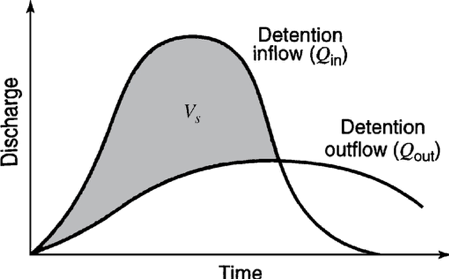Developing Storm Inflow and Outflow Hydrographs
HydroLearn

Problem Statement
Flash flooding is a hazard in many parts of the world. Flash flooding is common in mountain canyons, desert washes, and other such topographic areas featuring mountainous terrain where runoff from rainfall quickly accumulates in gullies or ravines. A flash flood is a sudden and rapid rise in stream water depth resulting from heavy, localized rainfall. With a growing population, developing neighborhoods in terrain susceptible to flash floods has become more common and therefore increased the potential for damage to private property and public infrastructure.
Hydrologists are frequently required to design flood protection infrastructure to protect people and property from the impacts of flash flooding. The last essential task in this process to complete the basin design is to establish inflow to the basin and investigate its outflow. This task involves developing storm inflow and outflow hydrographs which demonstrate the timing of streamflow and reservoir responses to the storm event.
Module Overview
In this module students will use runoff data from a design storm to learn how to develop inflow and outflow hydrographs.
Topics Covered
Inflow and Outflow Hydrographs, Modeling Using HEC-HMS
Pre-requisites
While each of the following mini-modules have been created as a stand-alone learning experience, we recommend implementing these modules in the following order for a comprehensive coverage of these topics:
1) Development of Design Storms (HL410)
2) Quantifying Runoff Generation (HL411)
3) Developing Storm Inflow and Outflow Hydrographs (HL412)
Learning Objectives
At the end of this case study, you should be able to describe and implement the steps involved in: developing a runoff hydrograph and designing a detention basin to provide flood protection.
This will be accomplished through activities within each section. Results from each activity will be recorded in specified results templates. The results templates for each activity can be found at the beginning of each activity. The results templates are organized such that results from one activity can easily be used in successive activities.
Course Authors
Emad Habib, PhD, PE
University of Louisiana at Lafayette. Contact: habib@louisiana.edu
Olivia LaHaye, Graduate Research Assistant
University of Louisiana at Lafayette. Contact: C00121316@louisiana.edu
Target Audience
Junior/Senior Hydrology and Water Resources Engineering Courses
Tools Needed
Computer with access to Internet, Excel, and free HEC-HMS software
Course Sharing and Adaptation
This course is available for export by clicking the "Export Link" at the top right of this page. If you are an Instructor seeking the answer keys, please contact the course creators using your official University email account.
Expected Total Hours
A student could expect to complete this module with approximately 5 work hours.
